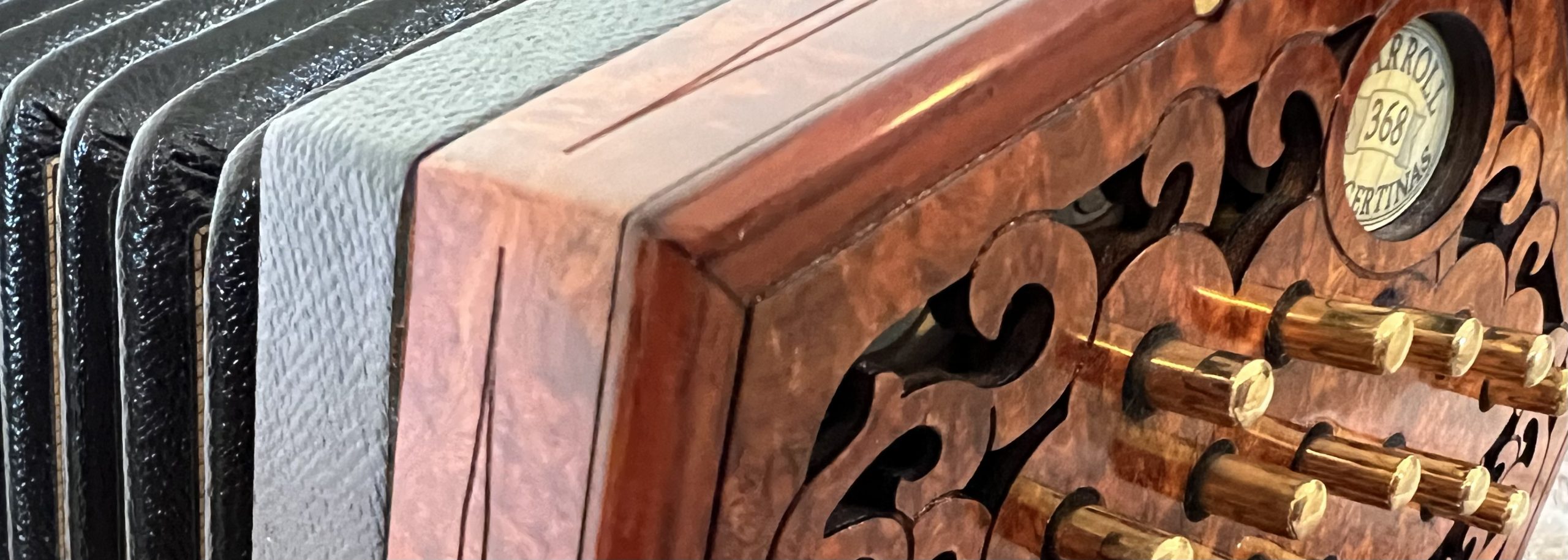Our History and Philosophy
In the Summer of 2002 work began on deconstructing a 1914 wood ended Wheatstone Linota in the basement of our home. Our first instrument, modeled on this Wheatstone, took a year and a half to build and, over the next several years, the operation slowly grew and reached a max output of about 24 instruments per year with a mix of 6 full and part time employees. In the Fall of 2024, we came full circle and made the painful decision to relocate our shop back into our home and downsize our workforce to only Wally and Jackie Carroll. One of our primary motivations in making this change is so that we can focus more on the creative aspects of the business rather than the managerial ones.
Under our old model of taking orders, we had many design and engineering ideas that we were never able to implement due to the pressures of serving the customers on our list. We’ve now begun introducing these ideas into our newest instruments and, beginning in 2025, every instrument we produce will also be unique in some manner from every instrument that we have previously made.
Our Instruments
Reeds:
The reeds in a concertina are often thought of as the soul of the instrument. Although many factors contribute to the particular tone and play-ability of an instrument, the reeds certainly play an enormous role in both regards. From a manufacturing standpoint, because of the incredibly tight tolerances and the various angles that need to be machined into the reed shoes, they also present the biggest challenge to the concertina maker. In our instruments, we only use what are known as “Traditional Concertina Reeds” which we manufacture ourselves. As in the vintage instruments, our reed shoes are made from brass and the tongues are made from blue tempered spring steel. The tongues are carefully profiled using sophisticated computer controlled grinding and cutting machines followed up by intensive hand filing. Our reeds are closely modeled on the reeds from a 1914 Wheatstone Linota.
Action:
The action in a concertina consists of the buttons, lever assemblies, pads and springs.
Buttons – The buttons are a combination of two parts: a plastic stem and a metal cap (brass or nickel silver). Using a plastic stem greatly reduces the weight of the instrument and is consistent with the practice of the earlier makers who often used either wood or plastic stems under metal caps.
Lever assemblies – The lever arms are cut from stainless steel sheets and are attached to the lever post with an adjustable screw. Vintage makers, Wheatstone and Jeffries, used crushed rivets to attach the lever arms to the posts. This system provides a more stable and therefore quieter and faster mechanism than some of the alternatives but it still has a problem in that over time, as the parts wear, a noticeable clicking sound develops (similar to a typewriter). It is sometimes possible to recrush the rivets a little to eliminate the clicking but it is very difficult to not go too far thereby causing the lever to permanently seize. After making several dozen instruments using riveted actions, we developed our own adjustable action which allows the owner to tighten the action the required amount in order to eliminate any clicking that may develop. We designed our own threaded rivet for this purpose and have it manufactured to an extremely close tolerance. It has the advantage in that if it is overtightened, the procedure can easily be reversed giving the owner endless attempts to get it right without causing any permanent damage.
Pads and Springs – We manufacture our pads using a sandwich of cardboard, felt and leather and we make our springs out of stainless steel wire.
Bellows:
Our bellows is made up of over 300 pieces of leather, linen, and cardstock. The leather that covers the outside of the bellows is a high quality bookbinder’s goatskin with an embossed ‘cross hatch’ texture similar to that found on vintage Wheatstone and Lachenal bellows. The bellows are available in solid black or with decorative papers.
Woodworking:
The most important wooden parts of the concertina, with respect to tone production, are the reedpans and the action boards. True to tradition, our reedpans and action boards are made from imported English Sycamore. Far less important, with respect to tone, are the ornate woods used on the ends of the instrument. Our ends are made in the traditional manner by laminating together multiple sheets of veneer to create a stable, rigid endplate. The advantage of using a laminated end over a solid wood end is that the instrument is far less prone to developing cracks (which is practically inevitable in a solid wood construction as can be seen in surviving lesser quality vintage instruments such as Lachenals and Jones). We never put solid ebony ends on our instruments as this wood is particularly prone to cracking and was actually rarely (if ever) used on vintage instruments.

